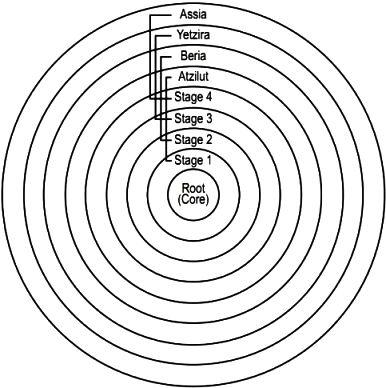
The wisdom of Kabbalah explains, that initially a single desire to receive was created, which as a result of the influence of the creating pure, bestowing force, evolved through four stages, until a raw desire is formed, which senses its total opposition to its source.
As a result of this unpleasant sensation of total opposition the desire restricts itself then builds a “self-control” structure, with a Rosh (head), with a single purpose, to direct its future development in a way of achieving full similarity with the source.
As soon add this “self-control” structure, called “the Partzuf,” is born, the system of “Creation,” begins to sort out the “unemployed” (non-similar, unable to bestow) desires on its waiting list, placing the weakest, easiest to handle desires at the top of the list, and the most intense, unruly ones at the bottom. Creation divides these desires into four categories, similar to the four stages in the evolution of desires. It refers to each category as an Olam (world), from the Hebrew word Haalama (concealment), since these desires must be kept separated and concealed from the lights until they can be operated correctly—with the aim to bestow. Thus, the desires with qualities most similar to Stage One are called “the world of Atzilut,” those most similar to Stage Two form “the world of Beria,” with those most similar to Stage Three forming “the world of Yetzira,” and those most similar to Stage Four becoming “the world of Assiya” (see diagram). For short, they are called “ABYA.”
When Kabbalists describe the spiritual realm—where desires work with the aim to bestow—they usually divide it into worlds and describe what happens in them (how desires actually receive). Therefore, they often refer to everything that precedes the worlds of ABYA as a world as well, and call it “the world of AK” (Adam Kadmon—the primordial man). In a way, the world of AK parallels the Root Stage, or Stage Zero, in the evolution of desires.
Note that our world is not mentioned among the spiritual worlds. Because our world is based on egoism, and the worlds in Kabbalah reflect levels of bestowal, our world is not considered part of the spiritual (with the aim to bestow) system.
How Development Comes from 2 Opposing Forces
The spiritual system is ceaselessly evolving through interaction among its forces, gradually making more of its desire capable of receiving with the aim to bestow, building each stage on conclusions and actions performed in its preceding stages. Similarly, as a baby grows, its physical and cognitive abilities develop by building on previously acquired capabilities and observations. Without going through these early stages of development, babies would not become adults. Of course, we do not, and need not keep those early-life observations in our consciousness while we go about our daily routine, since they have become automatic; yet, we constantly use them in our lives as adults.
With children, we help them acquire new capabilities and data, and we watch over them to make certain that they do not attempt to do things prematurely. Similarly, to complete creation’s “maturing” into being Creator-like, it needs to learn with which of its desires it can work (receive in order to bestow), as well as how and with which desires it still cannot work because it would reawaken the sense of inferiority and shame.
Hence, in each world, creation carefully examines the light (pleasure) that the desire to give wished to impart on it. In Atzilut, creation receives all the light, since Atzilut corresponds to the desire of Stage One—receiving all the light “automatically,” not getting its own desire to receive involved. For this reason, the desire-pleasure combination in Atzilut is called “still” or “inanimate,” since the desire is passive, still.
In Beria, creation receives less light because Beria corresponds to Stage Two, which is a more developed state of the desire to receive—a desire to give, like the Creator. Because Beria corresponds to the first desire that reacted to the light, it was given the name of the first level of life: “vegetative.”
In Yetzira, the creation receives even less light than in Beria because Yetzira corresponds to Stage Three in the desire to receive, which received only a little bit of light to begin with. Still, it is a more developed stage in the evolution of the desire to receive, showing a certain measure of autonomy. For this reason, it received the name of the level in evolution whose members display at least some autonomy—“animate.”
In Assiya, the creation receives so little of the light that it is not sensed as pleasure whatsoever, but as mere sustenance. Assiya corresponds to Stage Four in the evolution of desires, and just as Stage Four experienced the restriction, the world of Assiya is barred from experiencing the light. But because it corresponds to the latest, most developed, and most complex level of desire, it received the name of its corporeal parallel: “human” or “speaking.”
How Worlds are Differentiated by the Coarseness of Their Matter
In “The Essence of the Wisdom of Kabbalah,” Baal HaSulam explains that the worlds ABYA are all very similar to one another: “Kabbalists have found that the form of the four worlds, named Atzilut, Beria, Yetzira, and Assiya, beginning with the first, highest world, called Atzilut, and ending in this corporeal, tangible world, called Assiya, is exactly the same… This means that everything that eventuates and occurs in the first world is found unchanged in the next world, below it, too. It is likewise in all the worlds that follow it, down to this tangible world.
“There is no difference between them, but only a different degree, perceived in the substance of the elements of reality in each world. The substance of the elements of reality in the first, Uppermost world, is purer [more giving], than in all the ones below it, and the substance of the elements of reality in the second world is coarser [more receiving] than in that of the first world, but purer than all that is of a lower degree.
“This continues similarly down to this world before us, whose substance of the elements in reality is coarser and darker than in all the worlds preceding it [most receiving, to the point of egoism]. However, the shapes and the elements of reality and all their occurrences come unchanged and equal in every world, both in quantity and quality.”
Therefore, although Kabbalah speaks of desires, not of physical objects, because all worlds are practically identical, Kabbalists often use names of objects or processes from the physical world to explain spiritual states or processes that occur on the level of desires.
The Worlds Explained as Still, Vegetative, Animate & Speaking
Accordingly, in his “Introduction to the Book of Zohar,” Ashlag explains that the name, “still,” was given to the world of Atzilut because it consists of the desire to receive in Stage One, which is completely passive.
The corporeal equivalent of the world of Atzilut is minerals. All minerals strive (wish) to maintain their form. They have no desire to become anything other than what they already are; if you try to change them into something else, you will have to apply energy and manipulation on them because they will resist the change.
In Ashlag’s words, “Phase one of the will to receive, called ‘still,’ …is the initial manifestation of the will to receive in this corporeal world. … But no motion is apparent in its particular items. … And since there is only a small will to receive… its power over the particular items [minerals] is indistinguishable.”
Beria received the name, “vegetative,” since it is the beginning of an independent desire. As might be expected, the material manifestation of this desire is plants. Plants grow, blossom, and shrivel, and each plant is a distinct entity, as opposed to the aggregate of molecules that forms minerals. Yet, plants have no free choice in their movements. When plants of a certain kind grow in close proximity, they will all behave in exactly the same way. For example, the head of a sunflower plant will always turn toward the sun, and all wheat stalks turn yellow when harvest time approaches.
Yetzira was named, “animate,” and corresponds to Stage Three of the desire to receive. In Yetzira, the creation enjoys a substantial measure of “freedom and individuality …a unique life for each item,” writes Ashlag in the above-mentioned introduction. Yet, in Yetzira, he explains, “the desire still lacks the sensation of others, meaning there is no preparation to participate in others’ pains or joys.”
Assiya was named “speaking” or “human,” as it reflects the complete and most complex form of the desire to receive. At the human level, and Ashlag explains that this is a fundamental difference between the speaking and the animate levels, the will to receive includes the sensation of others: “The will to receive in the animate, which lacks the sensation of others, can only generate needs and desires to the extent that they are imprinted in that creature alone. But the human, who can feel others, too, becomes needy of everything that others have, and is thus filled with envy to acquire everything that others have.” For this reason, “when one has a hundred, he wishes to have two hundred, and so his needs forever multiply until he wishes to devour all that there is in the entire world.”
 “What are the Spiritual Worlds?” is based on the book, Self Interest vs. Altruism in the Global Era: How Society Can Turn Self Interests into Mutual Benefit by Dr. Michael Laitman.
“What are the Spiritual Worlds?” is based on the book, Self Interest vs. Altruism in the Global Era: How Society Can Turn Self Interests into Mutual Benefit by Dr. Michael Laitman.
